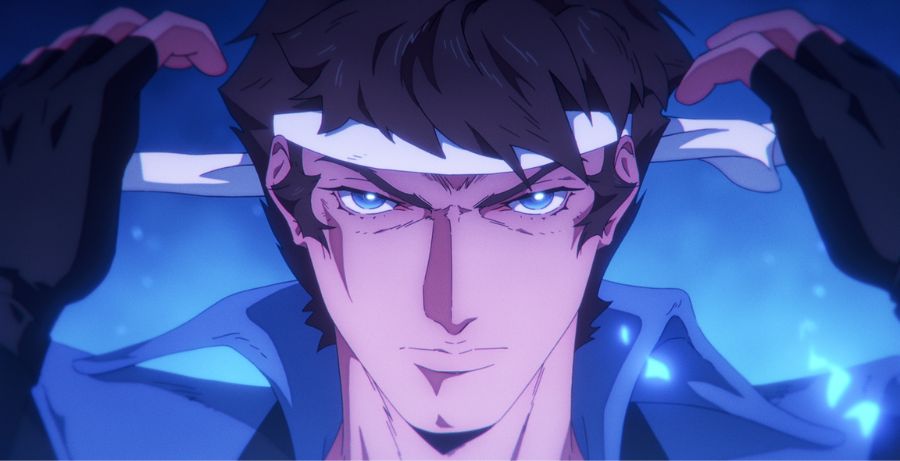This interview has been edited for length and clarity. For our full interview with the Castlevania: Nocturne Season 1 directors and showrunner, click here
Castlevania: Nocturne Season 1 is here and it’s expanding the world of the hit series, that some people would say broke the video game adaptation curse (it’s me, I’m some people). Set in the 18th century in the middle of the French Revolution, audiences are introduced to a new Belmont, and a new evil, the Vampire Messiah. In this interview, Directors Sam and Adam Deats and showrunner Kevin Kolde talk about bringing Castlevania to life, the changes in animation, Annette’s (Thuso Mbedu) journey from a footnote to a protagonist, and how Richter (Edward Bluemel) embodies a shonen protagonist in his growth.
When asked about the change in animation from the original Castlevania series to Castlevania: Nocturne Season 1 Director Sam Deats explained, “So it came from a few different angles. This was our first opportunity to do a refresh with the style. Across the four seasons of the original series, we got to slowly evolve things but we couldn’t necessarily totally redesign stuff or change styles or anything like that. So this is our chance to look at the style and play with something that felt relevant to the change in the story, as well as just a refinement of certain things. [We] started to move towards more delicate line work sometimes being a little less heavy-handed with shadows and instead being more particular with shadow shape for the design.”
One of the key stylistic elements of Castlevania as a series has been the way that Powerhouse Animation wholeheartedly embraced the artwork and bi-shonen style of Ayami Kojima, and in Castlevania: Nocturne Season 1, that influence pays off in the decadence of the French vampire aristocracy—especially in it’s lead Richter Belmont. Called “Little Boy Belmont” by Olrox (Zahn McClarnon), one of the series antagonists, Richter is much different than Trevor as a lead. He is, in many ways, a child. Yes, he has experienced trauma, but he has had the safety of a found family to hold him up.
On the topic, showrunner Kevin Kolde explained, “You’re right… He is young, and his life has been quite different than Trevor’s life. He had his travels with his mom, but he’s basically been living somewhat of a quiet life in France with Tera (Nastassja Kinski)and Maria (Pixie Davies). He’s dealt with vampires and things like that, he’s strong and he’s cocky, but he really hasn’t dealt with any of the danger. He doesn’t want to admit that he doesn’t have it covered, right? Underneath that, there’s there’s some things that he’s going to learn.”

Sam Deats added, “With Trevor… he was already a fully developed Belmont, but he needed to learn to care and to get back into the fight. So we enter things at a different point in his development than with Richter. He’s happened to have a bit of a coming-of-age story. And so, it is a very different point in his development… that gives us a different playground with stone locks than we have in the past.”
Adam Deats added more about Richter’s character design, “His look came naturally when Sam and Katie [Silva] were talking through what to do with Richter, who’s had, loosely speaking, about three or four different designs between Rondo of Blood, the Dracula X update, and then the iteration that’s appeared in Smash Brothers as well as slight differences here and there. And so they did something that put some of those elements together but also made him at home within our universe. For the bi-shounen part, well, every Belmont is a little bit of bi-shounen in some regard. They’re all hot goth guys.”
But Richter isn’t the only protagonist this season—there is also Annette. A resilient and powerful sorceress from Haiti, she brings in a new magic to the series outside of Europe. With the representation of Haitian Vodou and its Yoruba roots, she is the descendant of the Orisha god Ogun. Calling to other gods like Papa Legbha with the use of veves, she is one of the first times I’ve seen vodou in such a positive and powerful light. Not only that, but while other dark fantasy series shy away from the horrors of history, Castlvania: Nocturne is influenced by it, calling slavery by its name and allowing a Black protagonist and former slave to craft the narrative as much as Richter. Specifically in Episode 3, written by Zodwa Nyoni.

Kevin Kolde credited this success to fellow showrunner and writer Clive Bradley and Episode 3 writer Zodwa Nyoni. “It’s a credit to Clive [and Zodwa], and the writers on the show. Clive is a student of history. When we talked about setting the show during the French Revolution, it’s always about finding the right balance between history and fantasy. The way the stories in history are intertwined, and the way that he was able to bring characters from those different places, the Haitian Revolution, the French Revolution… I think that one of the things that’s unique about Nocturne is how grounded it is in those [historical] elements. We don’t really shy away from them.”
Castlevania: Nocturne Season 1 Episode 3 showcases Annette’s journey to France, her trauma, and her resiliency through it all. It also showcases her power and connection to her ancestors in a beautiful and unique way compared to the rest of the animation in the series. On that topic, Sam added context, “That [animation switch] was an idea that Tam Lu, the Episode Director for 103 had come up with, and he personally animated those shots, because he had a vision in mind for it. And I was just blown away. It made me emotional when I was watching the first fully composited take. It really drove home the feeling.”
With such a complex and beautiful sequence, Koley also added “I was watching it back the other day and sort of looking at the scenes with [Annette and Edouard] in the opera house, or in that bar, and just the lighting choices, the characters, they have a warmth and a glow to them. To convey the emotion and combine that with the story and acting in the music… I don’t have a lot of favorite episodes but [Episode 3] is definitely one of my favorite things that we’ve ever done for Castlevania.”

The heroes aren’t the only dynamic characters in the series. So are the villains. Koley explained, “That’s one of the things that I love about Castlevania is that sometimes the lines are a little blurred.” And on Olrox, the Aztec vampire with a backstory we’ve only been shown in small moments, the consensus is, “he’s complicated.”
Koley defines Orlox saying, “He’s definitely complicated. And that makes his story interesting. Even his interaction in the beginning with Julia [Belmont] is driven by something that is deeply emotional to him. He’s lived a long time, he’s seen a lot of things and, even his perspective on revolution and what’s happened in the story… he comes to it with an experience and a perspective that the other characters don’t have and they can’t have because they haven’t been there.”
Hardened by his age and what he’s seen, Olrox is also a character that refuses to yield. One of his defining character moments is when he’s asked to bow to the Vampire Messiah, which he does. However, as his body bends, his eyes remain up, locked with her. A sign of disrespect and his unwavering self. As Adam adds, “He can’t do it. He can’t.”
He continues, “My single favorite Olrox speech is actually in the sixth episode when he’s talking to Mizrak in the hotel room. And he’s talking about his background. That sequence, to me, is one of my favorite moments out of every season of the show that we’ve done. And I think that it really sums up his character in a really important way. I’m infinitely proud of what we did.”

Finally, the group explains what each of them wants the audience and fans to take away from Casltevania Nocturne Season 1. Adam Deats began, “Oh God, I hope they want more. I hope also that they think we did a decent job making this feel totally connected to the original series and not far removed. And that it feels like a natural progression, but also an evolution of it. That, to me, is the most important part. I’m really happy that we got to do four seasons of a show and actually finish it. It was a thing that I wanted to do from the very beginning. And the fact that we’re continuing it, there’s a lot of anxiety behind it.”
But for Sam, his hope is focused on the ending of the series and the big spoiler it holds. Sam Deats said, “I was just gonna say that I hope that they like the new Alucard design and think that he’s hotter than he was.”
Beyond the hot goth guy thirst, Kevin Kolde added, “For me… I feel like it’s an evolution of what we did before, to Adam’s point. It’s connected, but it’s an evolution. I hope people enjoy the story and enjoy the characters and become invested in some way… and really want to see more and continue their stories.”
Castlevania: Nocturne Season 1 is streaming now, exclusively on Netflix.
Castlevania – Season 1 | Season 2 | Season 3 | Season 4
Castlevania: Nocturne – Season 1 | Season 2







![[EXCLUSIVE] ‘Invincible VS’ Devs Dive Deep Into Their New Original Character: Ella Mental Ella Mental in Invincible VS](https://butwhytho.net/wp-content/uploads/2025/12/Invincible-VS-Ella-Mental-But-Why-Tho-1-450x247.jpg)